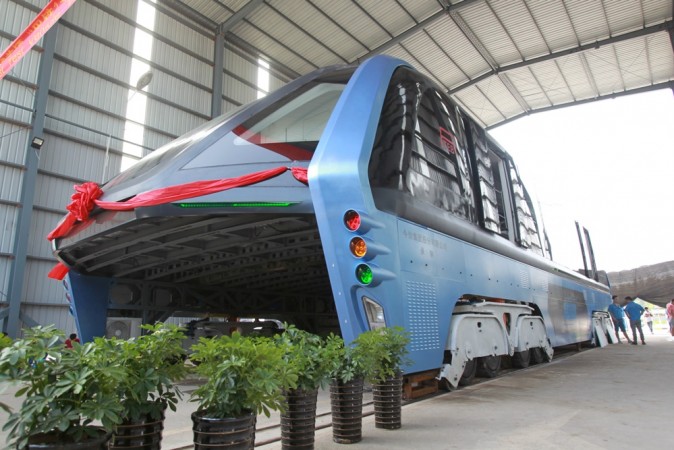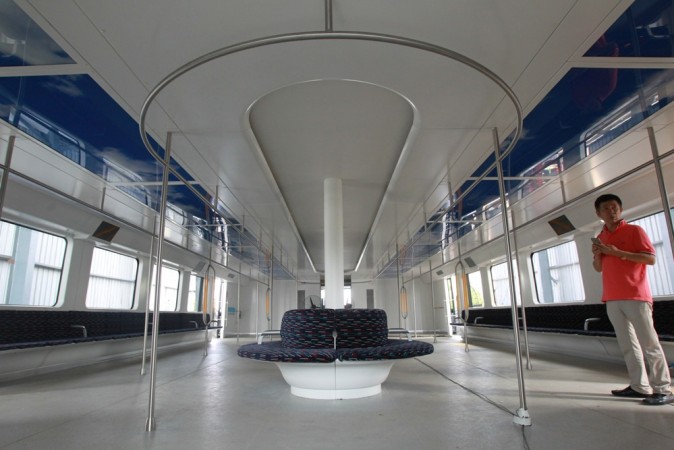By AUSTIN RAMZY and CAROLYN ZHANG

The traffic-straddling bus during its test run in Qinhuangdao in August. Last week, more than 30 members of the company behind the project were detained on suspicion of illegal fund-raising.
HONG KONG — Maybe a giant tram rolling over pesky cars clogging the streets wasn’t the answer to China’s traffic congestion woes.
A Chinese inventor’s plan to develop such a vehicle, called a “traffic-straddling bus,” has been effectively killed after 32 people from an investment company that backed the project were arrested.
The bus was designed to ride on tracks, but with its body elevated so that two lanes of traffic could pass underneath.
The bus was designed to ride on tracks, but with its body elevated so that two lanes of traffic could pass underneath.
But critics raised many questions, including the expense of installing tracks and stations, whether tall trucks would get stuck underneath and about the risk to smaller vehicles and pedestrians.
“Cars under the belly of the big vehicle would have no way to change direction, and even changing lanes would be dangerous,” The Beijing News said last year.
“Cars under the belly of the big vehicle would have no way to change direction, and even changing lanes would be dangerous,” The Beijing News said last year.
After some delays and breathless news coverage, the TEB-1, or Transit Elevated Bus, was tested in August in the northern seaside town of Qinhuangdao.

The 72-foot-long, 16-foot-high bus was designed to ride on tracks, with its body elevated so that two lanes of traffic could pass underneath.
In subsequent months, the Chinese news media and investors raised pointed questions about the company behind the project, Huaying Kailai.
The company promoted the “reliability” of investing in public-private partnerships like the bus initiative and promised annual returns of up to 12 percent.
A New York Times reporter who visited Huaying Kailai’s office in September saw walls lined with photographs of the owner, Bai Zhiming, with celebrities, entrepreneurs and local officials.
A half-dozen investors stopped by over an hour.
Some left with gifts and grocery bags full of cash.
“We are just a private tech company. We are not a briefcase company for illegal fund-raising,” Zhang Wei, the director of development and planning for TEB Tech, the Huaying Kailai subsidiary that developed the bus, told the reporter.
“We are just a private tech company. We are not a briefcase company for illegal fund-raising,” Zhang Wei, the director of development and planning for TEB Tech, the Huaying Kailai subsidiary that developed the bus, told the reporter.
“Everything we do is approved by related departments in the government, and if we are an illegal company with financial issues, why are the local governments still interested in us?”
In the fall, as public scrutiny increased, the test track and the huge, 72-foot-long, 16-foot-high prototype fell into disuse.
In the fall, as public scrutiny increased, the test track and the huge, 72-foot-long, 16-foot-high prototype fell into disuse.
In June, workers began dismantling the 330-yard track, a sign the local government would not allow the project to continue.
Mr. Bai was among the 32 Huaying Kailai staff members arrested last week on suspicion of illegal fund-raising, the Beijing police announced on Sunday.
Mr. Bai was among the 32 Huaying Kailai staff members arrested last week on suspicion of illegal fund-raising, the Beijing police announced on Sunday.
Company officials could not be reached for comment on Tuesday.
Chinese news outlets were harshly critical, saying the exercise was little more than a fraud from the start.
“The truth is the bus was a fake science investment scam, with no scientific innovation,” a Beijing News op-ed said on Monday.
“The truth is the bus was a fake science investment scam, with no scientific innovation,” a Beijing News op-ed said on Monday.
“The test was nothing more than a trick to attract investors.”






